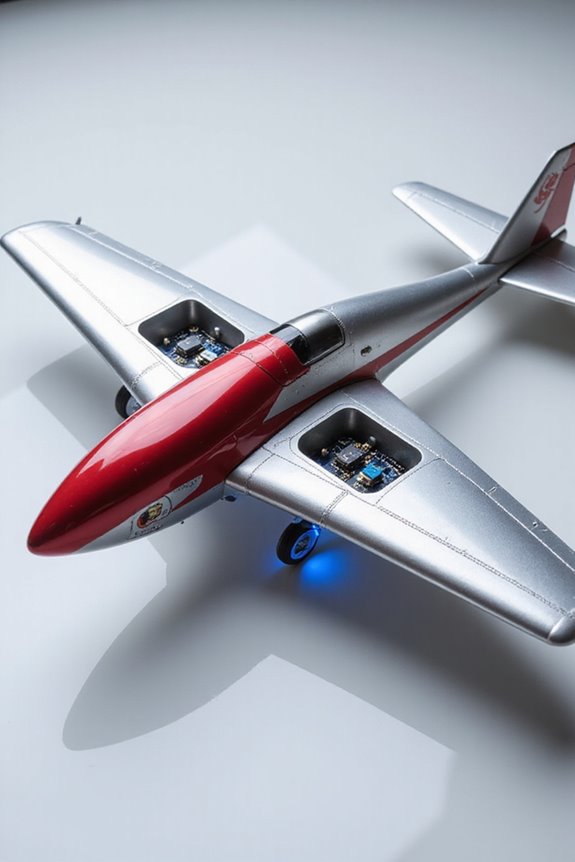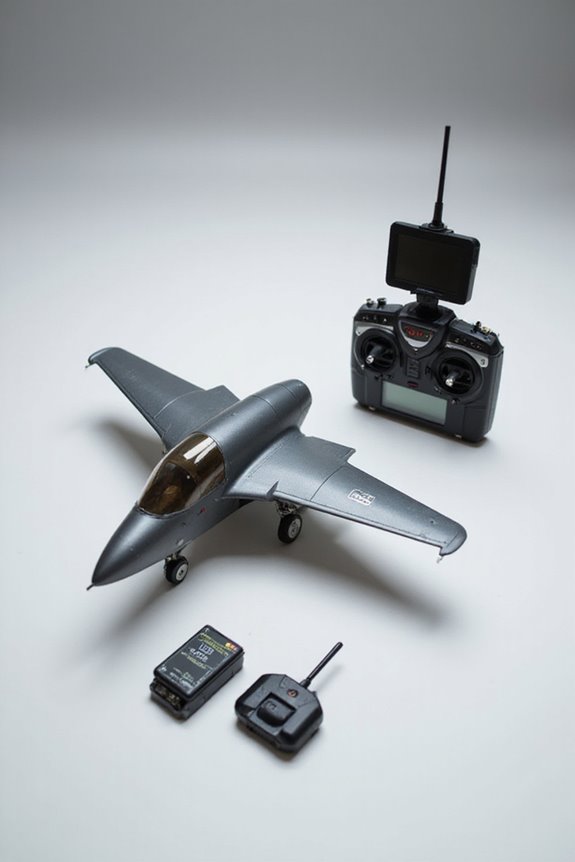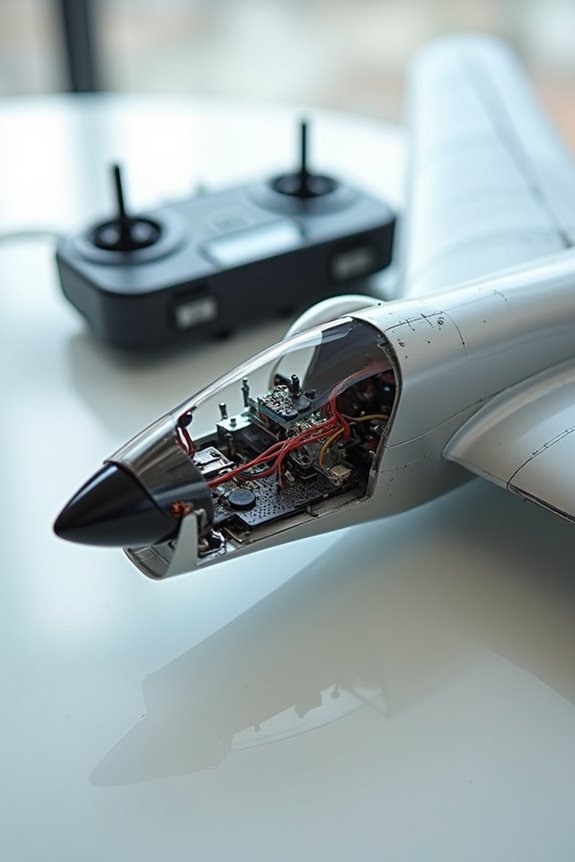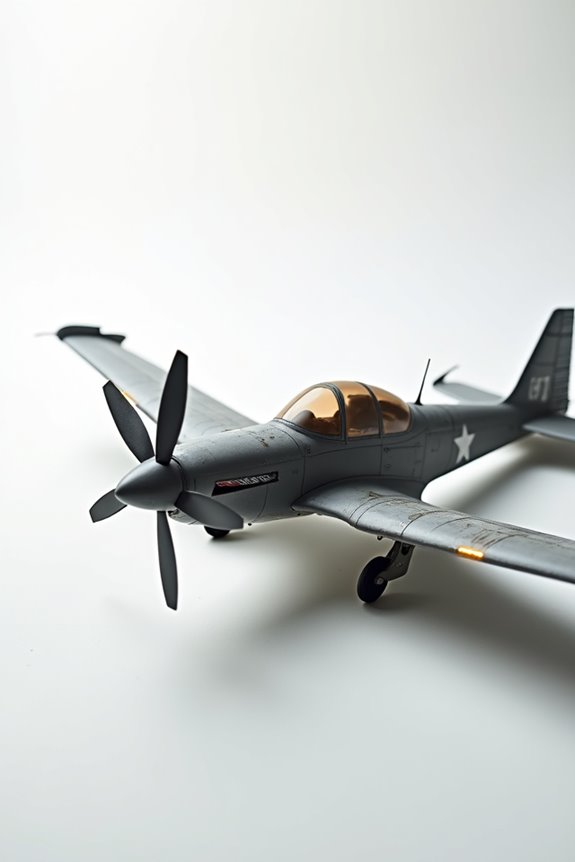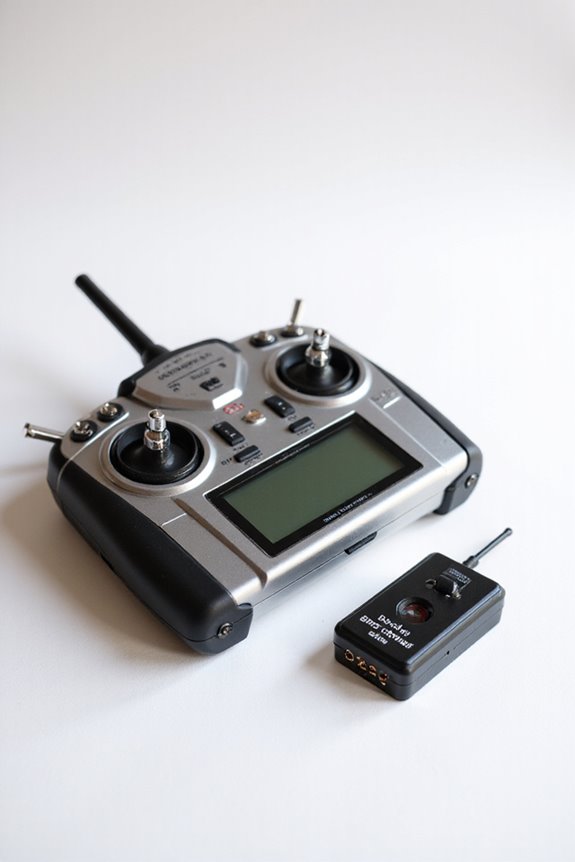When it comes to the best gyroscopic stabilizers for RC planes, we’ve got a few standout choices. The HobbyEagle A3 Pro offers advanced features that experienced pilots love, while the FMS Reflex V3 is perfect for beginners with its easy modes and quick setup. We can adjust sensitivity and enjoy smooth flights, whether we’re soaring or just starting out. Plus, these stabilizers make flying a breeze, even when the winds pick up. Stick around, and you’ll discover even more great options!
Key Takeaways
- Consider the HobbyEagle A3 Pro for reliable performance and advanced features, suitable for experienced pilots and various RC planes.
- The FMS Reflex V3 offers beginner-friendly modes and easy reprogramming via Bluetooth and USB-C connectivity, enhancing user experience for novices.
- Quanum Gyro provides an affordable option for stability, making it a great choice for budget-conscious hobbyists.
- The HobbyEagle A3 Lite boasts advanced stabilization features in a compact design, ideal for smaller RC aircraft.
- XPILOT System allows customizable flight modes and sensitivity adjustments, catering to different skill levels and enhancing safety during flights.
Overview of Gyroscopic Stabilizers
When we think about gyroscopic stabilizers, imagine having a trusty co-pilot right in your RC plane—one that never gets tired and always knows how to keep things steady! These systems utilize advanced sensor technology, combining gyroscopes and accelerometers for precise flight control. Gyros measure how fast our plane spins, while accelerometers track its movements in three dimensions.
The stabilization benefits are hard to ignore. They make flying easier, especially for beginners, by reducing pilot workload and preventing unwanted tip stalls. Even for advanced pilots, these stabilizers open up new aerobatic possibilities. With options ranging from basic two-channel systems to more complex six-axis units, every pilot can find a stabilizer that suits their style. It’s like having an extra set of hands in the cockpit!
Key Features to Consider
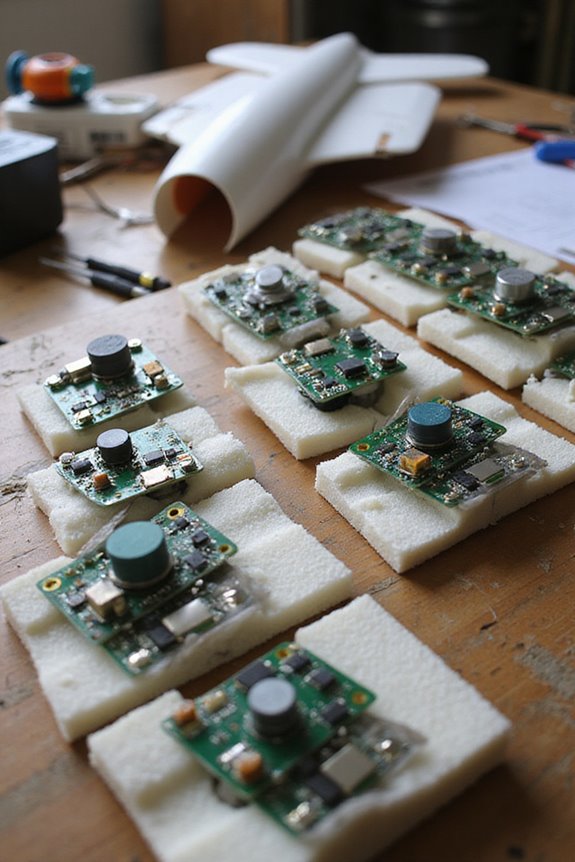
A good gyroscopic stabilizer can make all the difference in how our RC planes handle, so knowing what features to evaluate is key. First, we should look for adjustable sensitivity settings. These allow us to fine-tune the system based on our flying skills and the type of aircraft we’re using.
Next up is installation convenience. A plug-and-play setup is always a bonus, saving us from turning our workshop into a mess of wires! We want gyros compatible with various receivers and protocols, ensuring adaptability across our fleets.
Finally, having multiple stabilization modes can be a lifesaver. Whether we’re beginners or pros, these allow us to customize our flight experience, enhancing both safety and fun. After all, who doesn’t enjoy a bit of flying freedom?
Popular Gyroscopic Stabilizers on the Market
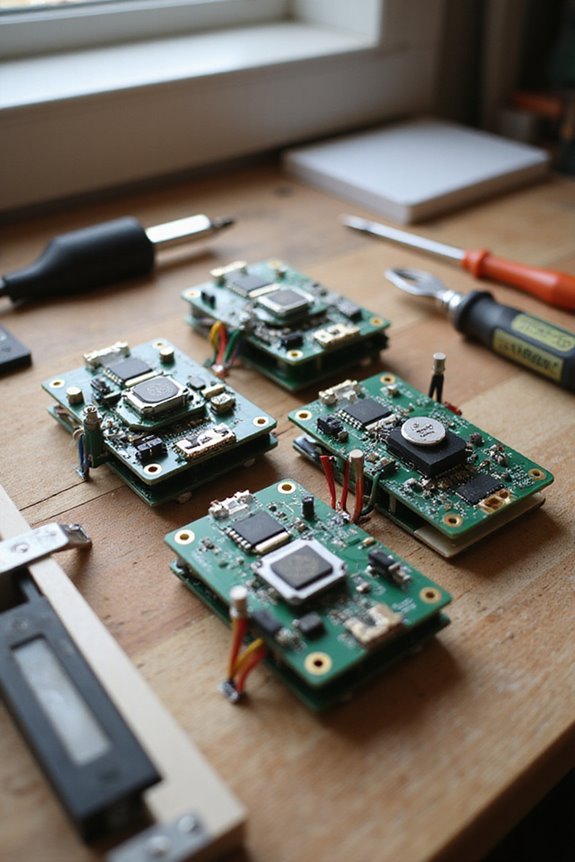
There’s a variety of impressive gyroscopic stabilizers on the market that can take our flying experience to the next level. For those on a budget, the Quanum Gyro is a fan favorite, offering great stability without breaking the bank. Meanwhile, the HobbyEagle A3 Lite packs in advanced features, ensuring control remains smooth.
If we want something more compact, the HobbyEagle A3 MINI is a nifty little option with 6-axis stabilization. Not to mention, the Freewing 3 Axis Flight Stabilizer and XPILOT System cater to both beginners and veterans. These models offer adjustable sensitivity and multiple flight modes. With these stabilizers, we’re sure to boost our confidence in the sky while adding some serious fun to our flights! Additionally, incorporating a gyro with high-precision sensors can significantly enhance flight stability and responsiveness.
Comparing FMS Reflexx V3 and HobbyEagle A3 Pro
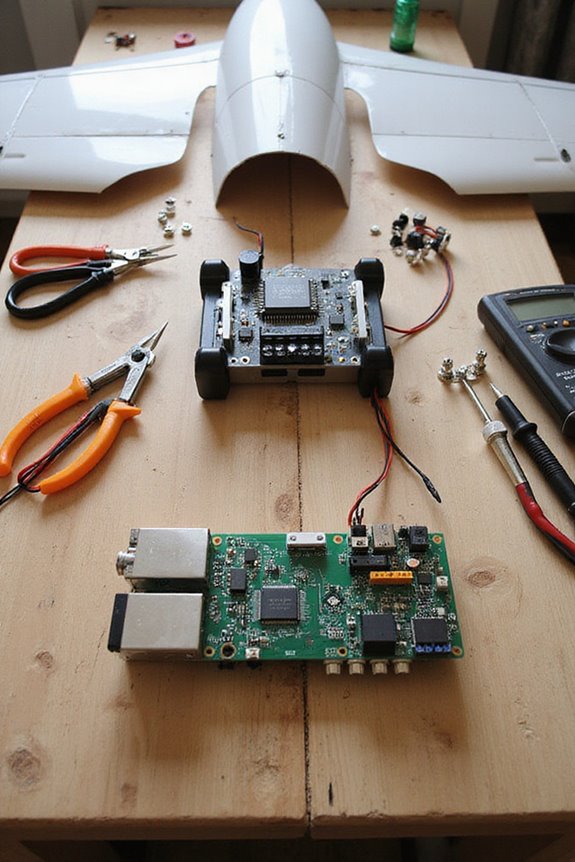
Upgrading our flying experience often leads us to compare different stabilizers, and two popular options are the FMS Reflex V3 and the HobbyEagle A3 Pro. The FMS Reflex V3 shines with its high-speed 32-bit ARM processor and beginner-friendly modes. With Bluetooth and USB-C connectivity, reprogramming is a breeze.
On the other hand, the HobbyEagle A3 Pro is renowned for its compatibility and reliability across various RC planes. While both offer impressive stabilization, the Reflex V3’s dedicated beginner mode makes it a standout for novices. The HobbyEagle A3 Pro suits experienced pilots craving advanced features. Ultimately, whether we’re starting out or finding our groove, both options deliver the smooth, stable flights we crave.
Analysis of Xfly Pulsar V2 and HobbyEagle A3-L V2
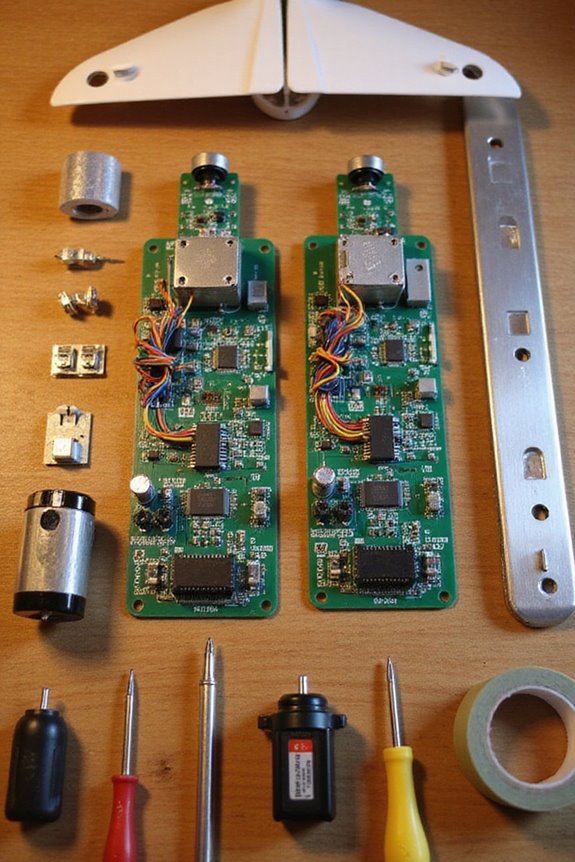
When diving into the world of gyroscopic stabilizers, we can’t overlook the Xfly Pulsar V2 and the HobbyEagle A3-L V2. The Xfly boasts advantages like high-performance stability and operational modes, including Lock and Balance, perfect for precise control. It also supports SBUS input, making integration seamless. Plus, at just 10 grams, it won’t weigh down your plane!
On the flip side, the HobbyEagle has some limitations. While it enhances stability and features gyroscopic functions, specifics on modes and setup are a bit fuzzy. It might also require some tuning, meaning you could spend more time fiddling than flying. So, for a hassle-free experience, the Xfly Pulsar V2 clearly takes the lead!
LemonRX vs. Freewing E51: A Comparative Review
In the world of RC planes, choosing the right gyroscopic stabilizer can feel a bit like picking a favorite dessert—there are just so many tasty options! The LemonRX shines with its stabilization modes like rate and autolevel, making it versatile for all skill levels. Plus, its telemetry compatibility gives us real-time data—ideal for those who love precision! Additionally, many planes equipped with advanced stabilization technology, including 6-axis gyroscopes, ensure smooth and controlled flight. On the flip side, the Freewing E51 has some limitations. We don’t have much information on its specific features or telemetry support, which makes it a bit of a mystery box. While gyroscopic systems typically stabilize against turbulence, the lack of detail on the Freewing E51 leaves us craving more. In the end, LemonRX definitely takes the cake here!
Installation and Setup Guide
Getting your gyroscopic stabilizer set up shouldn’t feel like solving a mystery. First, let’s talk space. Make sure there’s enough room at the center of gravity for installation. We can secure the unit using double-sided tape, mounting it parallel to the fuselage. Remember, that arrow on the gyro? It’s got to point toward the plane’s front!
Now for those wiring considerations, connect your aileron, elevator, and rudder to their channels. Don’t forget a mode switch for easy control. Be mindful of cable management too; a tidy setup avoids in-flight drama! Finally, adjust the gain pots after installation to fine-tune sensitivity. With these installation tips, we’ll keep our planes soaring smoothly through the skies!
Future Trends in Gyroscopic Stabilizers
Additionally, the integration of multiple sensors, such as accelerometers, means our planes will fly smoother than ever before. With processor advancements, newer gyro systems can react almost instantaneously, giving us amazing stability control. It’s like having a co-pilot that never gets tired!
More fun comes from miniaturization. Smaller gyros fit perfectly in compact models, boosting performance without excess weight. Plus, we can expect customization options that let us fine-tune settings according to our flying style—like ordering coffee just the way we like it!
Lastly, wireless updates will keep our systems optimized without any fuss. So, get ready for incredible innovation that breathes new life into our flying experiences. That’s what we call taking to the skies with style!
User Experiences and Reviews
User experiences with gyroscopic stabilizers reveal a lot about what works—and what doesn’t—in the sky. Many pilots rave about the budget-friendly LemonRX Stabilizers, praising their ease of use and solid stability, though others miss advanced features like a rescue mode.
We’ve seen the HobbyEagle A3 Super Series shine, especially with its wind rejection and customizable settings. Users recommend it for both beginners and intermediates—bonus points for its ability to adapt!
On the pricier side, the Zohd Kopilot combined with the Spektrum AR620 is often favored for its crash-avoidance features, despite the extra cost. Overall, user feedback is essential—we learn it’s not just about flying; it’s about flying smart. Additionally, the integration of smart technology in gyroscopic stabilizers is becoming increasingly popular among hobbyists.
Frequently Asked Questions
How Do Gyroscopic Stabilizers Improve Flight Performance?
Gyroscopic stabilizers greatly enhance flight stability by utilizing advanced sensor technology. They help us maintain control and precision during maneuvers, reducing pilot fatigue and errors, ultimately resulting in a smoother flying experience for everyone.
Can Beginners Use Gyroscopic Stabilizers Effectively?
Absolutely, we can effectively use gyroscopic stabilizers! They offer beginner benefits like enhanced flight stability and simplified handling. By employing various stabilization techniques, we can enjoy smoother flights while honing our skills with confidence.
What Is the Typical Lifespan of a Gyroscopic Stabilizer?
The typical lifespan of a gyroscopic stabilizer depends on several factors. Different stabilizer types react differently to usage conditions and maintenance practices, so we should prioritize quality and care to maximize their longevity.
Are There Any Maintenance Tips for Gyroscopic Stabilizers?
When maintaining our gyroscopic stabilizers, we should focus on proper installation techniques and keep firmware current. Regular calibration and thorough troubleshooting issues help guarantee peak performance and enhance our flying experience.
Do Gyroscopic Stabilizers Work in Windy Conditions?
In wild, windy conditions, we’ve seen stabilizers turn our planes from wobbling messes into smooth gliders! Their effectiveness truly shines, keeping us in control even while nature throws its best gusts at us.

